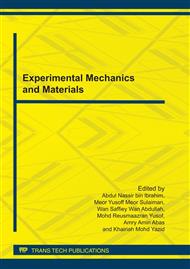p.1
p.7
p.13
p.19
p.22
p.28
p.35
p.41
p.48
Comparison in Phase Transformation of Calcium Phosphate and Zirconium Doped Calcium Phosphate Biomaterials by In Situ XRD
Abstract:
Pure calcium phosphate and ZrO2 doped calcium phosphate biomaterials were synthesized using an organic based phosphoric acid (DEHPA) as its starting material. The precipitated products obtained from the sol-gel reaction were then used to compare the phase transformation using in-situ XRD. The study shows that amongst the notable difference between these two samples is that the ZrO2 doped calcium phosphate tends to form the β-Ca(PO3)2, β-TCP and HA phases at lower heating temperatures compared to the pure calcium phosphate. Another major different seen in the phase transformation of the ZrO2 doped calcium phosphate is the transformation of β-TCP into HA before it leads to the formation of α-TCP at higher temperatures.
Info:
Periodical:
Pages:
22-27
Citation:
Online since:
July 2011
Price:
Сopyright:
© 2011 Trans Tech Publications Ltd. All Rights Reserved
Share:
Citation:


